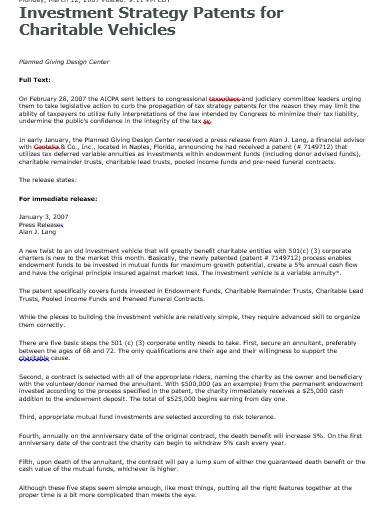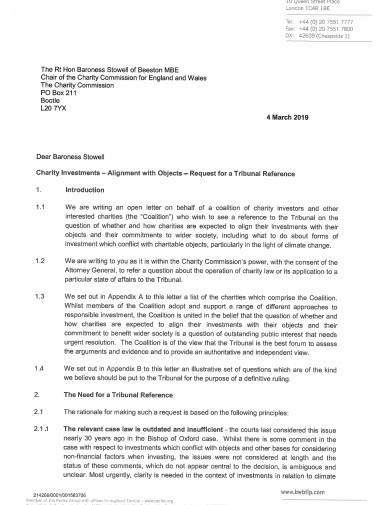An investment strategy is a term that refers to the principles that enable investors to accomplish their financial plans and investment goals. This is part of a management plan that serves as the investor’s guide in making decisions based on their business goals, risk assessment plan, and need for capital in the future. Investors can utilize strategic planning to create their own portfolios or collaborate with a financial professional. Investment strategies contain a list of factors that will help investors determine the type of investments they will choose to purchase like stocks, money market funds, real estate, and more.
FREE 3+ Charity Investment Strategy Samples & Templates in PDF | MS Word
1. Charity Investment Services Strategy
2. Charitable Parents Investment Strategy
3. Simple Charity Investment Strategy Template
4. Sample Charity Investment Strategy
What is a Charity Investment Strategy?
An effective nonprofit or charitable organization ensures that they are committed to maintaining a consistent, strong income stream, developing and implementing logical investment strategies, and managing accounting controls on a daily basis. These organizations must protect the continuity and balance of each of their income stream as well as ensure that they have a complete understanding of expectations while complying with all reporting requirements and restrictions on operations.
How to Create a Charity Investment Strategy
Investment strategies are methods of investing that enable individual and organizational investors to meet both their short and long-term goals. These strategies differ greatly from one another, meaning there is no certainty that a plan will work for every organization or person. Investment strategies also involve the need to reevaluate and realign plans and strategies as they develop to adapt their portfolios to their current situations or conditions.
Step 1: Determine Objectives and Capabilities
The board of the organization must evaluate the charity’s short and long-term goals. They must establish investment objectives that align with their mission statement as well as operations and financial needs.
Step 2: Assign an Officer for Accountability
The organization must conduct a thorough screening of officers who will be in charge of overseeing the investment managers within their boundaries of authority. The roles and responsibilities of the officer include authorizing investment strategies, approving transactions above a particular monetary level, reviewing account statements, and more.
Step 3: Choose an Investment Manager
Determine if your internal staff possesses the skill and professionalism to manage and handle the organization’s investment portfolio or if an independent professional like a bank firm should be retained or not.
Step 4: Create an Investment Policy Statement for Your Charity
Your charity’s investment policy statement is aimed at every member involved with your nonprofit organization which includes the trustees and employees, investment advisers or managers, beneficiaries and donors, and the Charity Commission.
FAQs
What should a charity investment policy statement include?
A charity’s investment policy statement should include details on the roles of the investment committee, investment objectives, investment policies, performance measurements, and reporting standards, spending policies, and donor restrictions.
What are the elements included in an investment policy?
The elements of an effective investment policy include the scope of work, objectives, the amount available, time horizon, liquidity needs, types of investments, people in charge of decision-making, key performance indicators, reporting requirements, responsibilities of the investment manager, investment manager’s principles, and responsibilities of the trustees.
What are the different types of investing?
There are three basic types of investing styles which are the conservative in which an investor has low to moderate risk tolerance, moderate in which the investor is willing to take risks so they could achieve stock price appreciation, and aggressive in which the investor wants to accomplish high overall return as well as willing to take more risk to do so.
Investment strategies are a style of investment that follows a set of policies and procedures to guide investors in creating their investment portfolio. These strategies guide the investor in making relevant decisions based on their business objectives and risk tolerance or profile. An investment policy is also crucial in designing investment strategies as it sets out the charitable organization’s goals and investment objectives. With this policy, the organization can make more effective investment decisions, help trustees in managing resources more effectively, and demonstrate that the organization is meeting all government regulations and responsibilities.
Related Posts
FREE 10+ Charity Mission Statement Samples and Templates in MS Word | PDF
FREE 10+ Charity Pay Policy Samples & Templates in MS Word | PDF
FREE 5+ Charity Investment Policy Samples & Templates in MS Word | PDF
FREE 10+ Charity Privacy Policy Samples & Templates in MS Word | PDF
FREE 10+ Charity Standing Order Form Samples & Templates in MS Word | PDF | MS Excel
FREE 10+ Charity Risk Management Policy Samples & Templates in PDF
FREE 5+ Charity Marketing Policy Samples & Templates in PDF
FREE 5+ Charity Recruitment Policy Samples & Templates in MS Word | PDF
FREE 3+ Charity Management Accounts Samples & Templates in PDF
FREE 10+ Charity Gift Aid Form Samples & Templates in MS Word | PDF
FREE 10+ Charity Strategy Samples & Templates in MS Word | PDF
FREE 6+ Charity Marketing Strategy Samples & Templates in MS Word | PDF
FREE 10+ Charity Financial Policy Samples & Templates in MS Word | PDF
FREE 10+ Charity Financial Policies and Procedures Samples & Templates in MS Word | PDF
FREE 10+ Charity Expenses Policy Samples & Templates in MS Word | PDF




